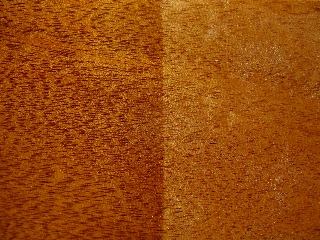Question
I have a situation that I am wondering if anyone can help me with or direct me to a resource that might help. We made and installed approximately 60lf of African mahogany veneer and Santos mahogany hardwood bookshelf type units for a client about half a year ago.
There are windows in the room with natural light and they have just contacted me asking why, when they move decorations around, the wood is darker in the areas that have been covered up. They have a clear conversion finish and I know this is natural from the exposure to the light but I don't know exactly how to explain it to them and have it sound right.
Forum Responses
(Finishing Forum)
From contributor R:
Yellowing and lightening will occur with many types of mahogany when exposed to UV. Sadly, it isn't all that evenly sometimes. The fact is, many species are sensitive to light (UV) and will change. Many are favorable, however mahogany is not. Refinish it and keep out of direct sunlight. Who chose the species in the first place? Cherry looks great when exposed to UV and so does walnut. There are some good marine varnishes that contain UV blockers, but they will only slow the process. Remember, dark mahogany in dark rooms.

Wood is composed of atoms which are surrounded by a field of electrons. Electrons like to operate in pairs. When wood is subjected to light, especially UV light, these electrons get very excited and one of a pair will often take flight, leaving behind a sick atom called a free radical. Free radicals are usually unstable and will eventually morph into something else. Thus begins the process of photochemical oxidation which will continue through many steps and can lead to complete oxidation. It is inevitable - you can slow it down but you canít stop it.
When wood oxidizes its properties (including color) change. Since wood species are chemically different, the changes due to oxidation are different in different species. Some oxidize very quickly, some very slowly. Some oxidized wood is very attractive, some is very dull. In your case the mahogany will darken over time with exposure to light. UV light just accelerates the process.
It is also true that wood finishes and stains photo chemically oxidize. In the case of stains, earth pigments are usually pretty stable but manufactured colorants and especially dyes are often not as stable. When they oxidize they usually fade. Finishes also oxidize. In some finishes a component called a free radical absorber is added to capture the free radicals that pop up but this protects the finish, not the wood. In other cases a UV absorber is added to reduce the effects of UV on the wood. It operates much as sunscreen does for your skin but it will not stop the process. If possible your customer needs to accept the inevitable. Try not to cover any of the wood until its color stabilizes.